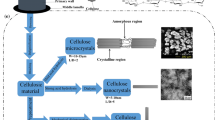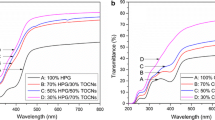Abstract
Cellulose nanocrystals (CNCs), extracted from trees, plants, or similar cellulose-containing materials, can be used in combination with other materials to improve their performance or introduce new applications. The main purpose of this study was to compare and understand the potentialities, as coatings for Poly(ethylene terephthalate) films, of CNCs obtained starting from the same cotton linters by two different processes: sulfuric acid hydrolysis and a less common treatment with ammonium persulfate (APS), able to provide also a cellulose oxidation. The results showed that CNCs produced through the APS treatment showed higher charge densities, due to the carboxylic groups formed during the process, higher crystallinity, higher clarity of the solution and, as a consequence, higher transparency of the coating. These characteristics provide a higher oxygen barrier with respect to the CNCs produced by the H2SO4 treatment, together with the availability of active sites for potential surface modification or chemical grafting. Both CNC coatings showed oxygen permeability coefficients that were lower than synthetic resins commonly used in flexible packaging. Furthermore, they did not significantly affect the optical properties of the substrate, while revealing good friction coefficients. Due though to the moisture sensitivity of the coating and its non-sealable nature, similar to EVOH or PVOH oxygen barrier synthetic resins, CNCs developed using APS will need to be laminated with another plastic layer such as a polyolefin. They could then be used to enhance the final properties of packaging solutions as an alternative to conventional food-packaging materials for perishable food products, while reducing their environmental impact with a thin layer of a bio-based polymer.







Similar content being viewed by others
Explore related subjects
Discover the latest articles and news from researchers in related subjects, suggested using machine learning.References
Arola S, Tammelin T, Setala H, Tullila A, Linder MB (2012) Immobilization-stabilization of proteins on nanofibrillated cellulose derivatives and their bioactive film formation. Biomacromolecules 13(3):594–603. doi:10.1021/Bm201676q
Beck-Candanedo S, Roman M, Gray DG (2015) Effect of reaction conditions on the properties and behavior of wood cellulose nanocrystal suspensions. Biomacromolecules 6(2):1048–1054. doi:10.1021/bm049300p
Beer F, Muller J (1962) Process for the production of caro’s acid salts and solutions thereof. In Google Patents. https://www.google.com/patents/US3036885. Accessed 08 July 2015
Belbekhouche S, Bras J, Siqueira G, Chappey C, Lebrun L, Khelifi B, Marais S, Dufresne A (2011) Water sorption behavior and gas barrier properties of cellulose whiskers and microfibrils films. Carbohydr Polym 83:1740–1748
Berne BJ, Pecora R (2000) Dynamic light scattering: with applications to chemistry, biology, and physics. Courier Corporation, New York
Bondeson D, Mathew A, Oksman K (2006) Optimization of the isolation of nanocrystals from microcrystalline cellulose by acid hydrolysis. Cellulose 13(2):171–180. doi:10.1007/s10570-006-9061-4
Cheng M, Qin Z, Liu Y, Qin Y, Li T, Chen L, Zhu M (2014) Efficient extraction of carboxylated spherical cellulose nanocrystals with narrow distribution through hydrolysis of lyocell fibers by using ammonium persulfate as an oxidant. J Mater Chem A 2(1):251–258. doi:10.1039/C3TA13653A
Crank J (1979) The mathematics of diffusion. Oxford University Press, Oxford
Dong XM, Kimura T, Revol JF, Gray DG (1996) Effects of ionic strength on the isotropic-chiral nematic phase transition of suspensions of cellulose crystallites. Langmuir 12(8):2076–2082. doi:10.1021/la950133b
Dufresne A (2012) Nanocellulose: from nature to high performance tailored materials. Walter de Gruyter, Berlin
Elazzouzi-Hafraoui S, Nishiyama Y, Putaux JL, Heux L, Dubreuil F, Rochas C (2008) The shape and size distribution of crystalline nanoparticles prepared by acid hydrolysis of native cellulose. Biomacromolecules 9(1):57–65. doi:10.1021/Bm700769p
Espino E, Cakir M, Domenek S, Román-Gutiérrez AD, Belgacem N, Bras J (2014) Isolation and characterization of cellulose nanocrystal sfrom industrial by-productsof Agave tequilana and barley. Ind Crop Prod 62:552–559
Favier V, Canova GR, Cavaillé JY, Chanzy H, Dufresne A, Gauthier C (1995) Nanocomposite materials from latex and cellulose whiskers. Polym Adv Technol 6(5):351–355. doi:10.1002/pat.1995.220060514
Filpponen I (2009) The synthetic strategies for unique properties in cellulose nanocrystal materials. Dissertation, North Carolina State University
Filson PB, Dawson-Andoh BE (2009) Sono-chemical preparation of cellulose nanocrystals from lignocellulose derived materials. Bioresour Technol 100(7):2259–2264. doi:10.1016/j.biortech.2008.09.062
French AD (2014) Idealized powder diffraction patterns for cellulose polymorphs. Cellulose 21:885–896
Gall JF, Church GL, Brown RL (1943) Solubility of ammonium persulfate in water and in solutions of sulfuric acid and ammonium sulfate. J Phys Chem 47(9):645–649. doi:10.1021/j150432a003
Håkansson H, Ahlgren P (2005) Acid hydrolysis of some industrial pulps: effect of hydrolysis conditions and raw material. Cellulose 12(2):177–183. doi:10.1007/s10570-004-1038-6
Ifuku S, Tsuji M, Morimoto M, Saimoto H, Yano H (2009) Synthesis of silver nanoparticles templated by TEMPO-mediated oxidized bacterial cellulose nanofibers. Biomacromolecules 10(9):2714–2717. doi:10.1021/bm9006979
Jayakrishnan A, Shah DO (1984) Phase-transfer-catalyzed polymerization of acrylonitrile. J Appl Polym Sci 29(9):2937–2940. doi:10.1002/app.1984.070290921
Kaelble DH (1970) Dispersion-polar surface tension properties of organic solids. J Adhes 2(2):66–81. doi:10.1080/0021846708544582
Kolthoff I, Miller I (1951) The chemistry of persulfate. I. The kinetics and mechanism of the decomposition of the persulfate ion in aqueous medium. J Am Chem Soc 73(7):3055–3059
Kralchevsky PA, Nagayama K (1994) Capillary forces between colloidal particles. Langmuir 10(1):23–36
Kroeger A, Deimede V, Belack J, Lieberwirth I, Fytas G, Wegner G (2007) Equilibrium length and shape of rodlike polyelectrolyte micelles in dilute aqueous solutions. Macromolecules 40(1):105–115
Lam E, Leung ACW, Liu Y, Majid E, Hrapovic S, Male KB, Luong JHT (2013) Green strategy guided by Raman spectroscopy for the synthesis of ammonium carboxylated nanocrystalline cellulose and the recovery of byproducts. ACS Sustain Chem Eng 1(2):278–283. doi:10.1021/sc3001367
Lasoski SW, Cobbs WH (1959) Moisture permeability of polymersl. I. Role of crystallinity and orientation. Polym Sci 36(130):21–33. doi:10.1002/pol.1959.1203613003
Leung A, Hrapovic S, Lam E, Liu YL, Male KB, Mahmoud KA, Luong JHT (2011) Characteristics and properties of carboxylated cellulose nanocrystals prepared from a novel one-step procedure. Small 7(3):302–305. doi:10.1002/smll.201001715
Leung CW, Luong JHT, Hrapovic S, Lam E, Liu Y, Male KB, Mahmoud K, Rho D (2012) Cellulose nanocrystals from renewable biomass. In Google Patents https://www.google.com/patents/US8900706. Accessed 08 July 2015
Li F, Biagioni P, Bollani M, Maccagnan A, Piergiovanni L (2013a) Multi-functional coating of cellulose nanocrystals for flexible packaging applications. Cellulose 20(5):2491–2504. doi:10.1007/s10570-013-0015-3
Li F, Biagioni P, Finazzi M, Tavazzi S, Piergiovanni L (2013b) Tunable green oxygen barrier through layer-by-layer self-assembly of chitosan and cellulose nanocrystals. Carbohydr Polym 92(2):2128–2134. doi:10.1016/j.carbpol.2012.11.091
Li F, Mascheroni E, Piergiovanni L (2015) The potential of nanocellulose in the packaging field: a review. Packag Technol Sci 28(6):475–508. doi:10.1002/pts.2121
Mewis J, Wagner NJ (2012) Colloidal suspension rheology. Cambridge University Press, Cambridge
Miller KS, Krochta JM (1997) Oxygen and aroma barrier properties of edible films: a review. Trends Food Sci Technol 8(7):228–237. doi:10.1016/S0924-2244(97)01051-0
Nickerson RF, Habrle JA (1947) Cellulose intercrystalline structure. Ind Eng Chem 39(11):1507–1512. doi:10.1021/ie50455a024
Nishiyama Y (2009) Structure and properties of the cellulose microfibril. J Wood Sci 55:241–249
Nishiyama Y, Langan P, Chanzy H (2002) Crystal structure and hydrogen-bonding system in cellulose Iβ from synchrotron X-ray and neutron fiber diffraction. J Am Chem Soc 124(31):9074–9082. doi:10.1021/ja0257319
Nishiyama Y, Kim UJ, Kim DY, Katsumata KS, May RP, Lagan P (2003a) Periodic disorder along ramie cellulose microfibrils. Biomacromolecules 4:1013–1017
Nishiyama Y, Sugiyama J, Chanzy H, Langan P (2003b) Crystal structure and hydrogen bonding system in cellulose Iα from synchrotron X-ray and neutron fiber diffraction. J Am Chem Soc 125:14300–14306
Nishiyama Y, Johnson GP, French AD (2012) Diffraction from nonperiodic models of cellulose crystals. Cellulose 19:319–336
Okano T, Kuga S, Wada M, Araki J, Ikuina JP (1999) Nisshin Oil Mills Ltd. Japan Patent JP 98/151052
Owens DK, Wendt RC (1969) Estimation of the surface free energy of polymers. J Appl Polym Sci 13(8):1741–1747. doi:10.1002/app.1969.070130815
Patterson A (1939) The Sherrer formula for X-ray particle size determination. Phys Rev 56:978–982
Pines A, Gibby MG, Waugh JS (1973) Proton-enhanced NMR of dilute spins in solids. J Chem Phys 59(2):569–590. doi:10.1063/1.1680061
Qi A, Chan P, Ho J, Rajapaksa A, Friend J, Yeo L (2011) Template-free synthesis and encapsulation technique for layer-by-layer polymer nanocarrier fabrication. ACS Nano 5(12):9583–9591. doi:10.1021/nn202833n
Roisnel T, Rodríguez-Carvajal J (2001) WinPLOTR: a Windows tool for powder diffraction pattern analysis. Mater Sci Forum 378(3):118–123
Roman M, Winter WT (2004) Effect of sulfate groups from sulfuric acid hydrolysis on the thermal degradation behavior of bacterial cellulose. Biomacromolecules 5(5):1671–1677. doi:10.1021/bm034519+
Salame M (1989) The use of barrier polymers in food and beverage packaging. In: Finlayson KM (ed) Plastic film technology, vol 1. Technologic Publishing Co. Inc., Lancaster
Springer EL, Minor JL (1991) Delignification of lignocellulosic materials with monoperoxysulfuric acid. United States Patent 5,004,523 issued April 2, 1991
Turrentine JW (1906) Action of ammonium persulphate on metals. J Phys Chem 11(8):623–631. doi:10.1021/j150089a004
Van Oss CJ (2003) Long-range and short-range mechanisms of hydrophobic attraction and hydrophilic repulsion in specific and aspecific interactions. J Mol Recognit 16(4):177–190
Yang H, Alam MN, van de Ven TGM (2013) Highly charged nanocrystalline cellulose and dicarboxylated cellulose from periodate and chlorite oxidized cellulose fibers. Cellulose 20(4):1865–1875
Acknowledgments
The authors wish to acknowledge Professor Francesco Demartin and Dr. Stefano Checchia, Department of Chemistry, University of Milan and Dr. Giorgio Capretti of INNOVHUB-SSI, Milan, for technical support in analysis and scientific support.
Author information
Authors and Affiliations
Corresponding author
Electronic supplementary material
Below is the link to the electronic supplementary material.
Rights and permissions
About this article
Cite this article
Mascheroni, E., Rampazzo, R., Ortenzi, M.A. et al. Comparison of cellulose nanocrystals obtained by sulfuric acid hydrolysis and ammonium persulfate, to be used as coating on flexible food-packaging materials. Cellulose 23, 779–793 (2016). https://doi.org/10.1007/s10570-015-0853-2
Received:
Accepted:
Published:
Issue Date:
DOI: https://doi.org/10.1007/s10570-015-0853-2




